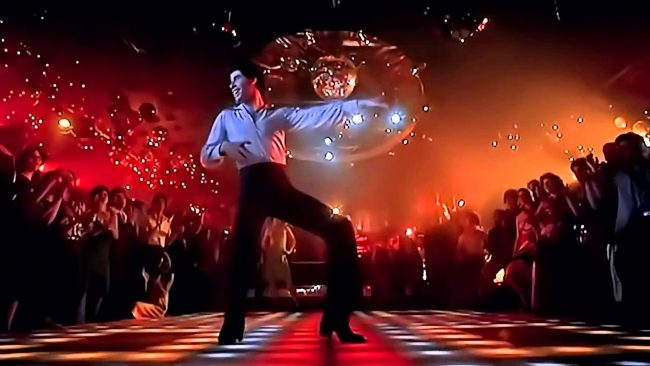Saturday Night Fever (1977) Stayin’ Alive and a Can Of Paint

Saturday Night Fever is a music and dance drama about a young Brooklyn man with a dead-end day life who rules the nights at the local disco. One of the most iconic and influential films of all time, this critically acclaimed movie was a huge box office success that has come to define an entire decade.
Say you’re making a list of the greatest opening moments in the history of cinema. You might have a few movies jump to mind, but in truth, right away you’re going to put Star Wars Episode IV: A New Hope at the very top because really, let’s be honest, duh. In terms of storytelling, tone, direction, and awesome, that’s the top, the middle, the bottom and everything in-between. It’s whole list.

Now let’s pretend we’re not crazy people and assume the list can have more titles than just Star Wars. That said, in struts the John Badham film Saturday Night Fever, which, interestingly enough, was released the same year as Star Wars. It’s opening is three and a half minutes of pure movie magic and for a film set in a very specific time has ironically enough become timeless.
It starts with an establishing shot of the New York City skyline viewed from Brooklyn, and cuts to an arial shot of the Hudson River and a bit of the Verrazano-Narrows Bridge, which has an important part to play later in the film and stands an a metaphor for a life in the past and one in the future. The camera settles over the Bay Ridge neighborhood and to an elevated graffiti-marked train that pulls away, suggesting it has just dropped us off officially into the story. Meanwhile, the first notes of The Bee Gees Stayin’ Alive rise out of the train’s departing clatter and we leave the platform and head down to a shoe store window display and a man’s platform leather loafer. On the other side of the glass, on the street, is our first glimpse of Anthony “Tony” Manero (John Travolta) a 19-year-old Italian American who is comparing his shoes with the store model. Satisfied they are similar, signaling the character’s need and pursuit of trendy fashion, he moves on and the music kicks in with full 70s disco music glory.
We now follow his shoes and the black bell-bottom polyester slacks above them as the film’s title, in a blood red neon font fills he screen. Or rather the shoes follows us as Tony’s feet march right up onto the camera lens. In perfect step with the tune, Tony swaggers his way down the street, cocking his head to the side, openly ogling pretty young ladies while cutting a wide swatch of testosterone heat as he goes. The camera itself can barely maintain its lock, tilting as if losing stability in the young man’s volcanic presence.

In his hand is a gallon of paint, and while we will learn why in minute, for now, it is a mystery. But what’s more important is its rhythmic movement in Tony’s swaying arm. It’s utterly memorizing, hypnotic even and somehow shifts our perception of the character. He is stylishly dressed, his hair coiffed to perfection, and he walks with staggering confidence, yet this little can of paint somehow immediately grounds him like an anchor where we can draw parallels to what comes later, his reigning superstardom on the dance floor by night and his daytime job as a worker by day. What this moment clues us to is that while both worlds exist independently, they are on the same axis and are as such influenced greatly by the other, with the lure of the disco dancing lifestyle the stronger of the two.
As the scene expands, we see Tony order and get a couple of slices of pizza (the girl taking the order speaking the first words in the movie and played by Travolta’s real-life little sister), and then rejected by an attractive woman on the street, though he’s hardly set back by it. All the while the Bee Gees keep singing and Tony keeps strutting. These are the trademarks that will define the entire film of course and while they evolve as Tony does, it is this brilliant introduction during the opening credits that remains groundbreaking.
Badham, like many of the directors of the time, is a storyteller, and it’s easy to think how a modern remake of Saturday Night Fever would begin with narration, a crutch that far too many movies rely upon rather than letting their visuals and creativity do the talking. As it stands, the opening moments of this classic are so well orchestrated and performed, we sit with just enough understanding to remain aware but more filled with wonder and curiosity as what will happen next. A can of paint and a disco beat have never been better put together. It’s a great moment.
